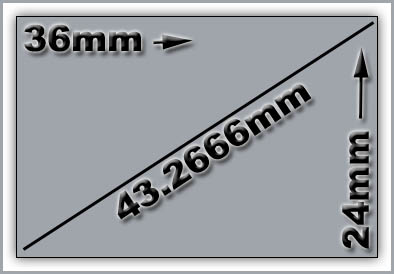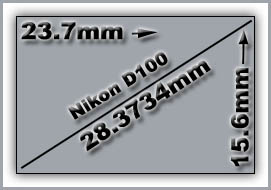
| Home • Reviews • Forums • News 2015 • 2013 • 2012 • 2009 • 2008 • 2007 • 2006 • 2005 • 2004 RSS Feeds • FOV Factor Table • Sensor Sizes | Definitions: A-D • E-H • I-L • M-P • Q-U • V-Z | Sitemap Articles • Archived Websites (Pre-DigitalDingus): D100 Lounge • E-10 Club | Contact |
| The Field Of View Equivalency Factor "The FOV Thing" |
|
| How do you get that number? December 26, 2004 |
|
| FOVEF: Introduction • FOVEF: Image Circles FOVEF: Olympus Four-Thirds Lenses • FOVEF: Nikon DX Lenses • FOVEF: How Do You Get That Number? FOVEF: Degrees and Angles Of View • FOVEF: Conclusion
|
|
It's pretty simple. And maybe you figured it out when you looked at the FOV Factor Table. When we discuss the FOV Factor, we are comparing two important measurements. These numbers are the diagonal measurements of the imagers. The diagram below shows the measurement of a 35mm image size, which is 43.27mm, but I put 43.2666mm to be a little more accurate. Some people say 43.26mm, some say 43.27mm.

The diagonal measurement is obtained by using an old formula you used in high school, and probably thought you would never use it again. The Pythagorean Theorem. Well, you can promptly call up your Geometry teacher and inform him or her, you have finally found a use for it!
As you probably don't remember, the Pythagorean Theorem deals with a height, a width, and a diagonal measurement of a triangle. It states the following:
"A" is one side of the triangle, "B" is another side, and "C" is the hypotenuse. Now, when we discuss FOV Factors, this theorem is made-to-fit. Why? Well, it's because we have to figure out the diagonal measurement (the hypotenuse) of the imager. Notice above how we already have the diagonal measurement in the illustration. We obtained it by using the Pythagorean Theorem.
1) 362 + 242 = 1872
2) sqrt1872 = 43.2666
Let's take a look at another imager (the Nikon D100) and it's diagonal measurement, but now, I will let you figure out how the diagonal was obtained. All you have to do is plug in the numbers provided to you on this page to get the number.

Since we have both diagonals, lets do the following:
43.2666 / 28.3734
The resulting number is 1.5249. This is the FOV Crop Factor, or FOVEF (Field Of View Equivalency Factor) of a Nikon D100/D70 DSLR. Now, of course this number is going to vary, according to the manufacturer's specifications, and whether we use the actual sensor area which records the pixels, or the overall size of the sensor itself. I personally use the size of the sensor that is specified in the owner's manual of the cameras, or by corresponding with the manufacturers. Nikon's FOV Factors vary just a little (as you can see in the FOV Factor Table), but overall, it's 1.5 for all of their current DSLR cameras (except for the Nikon D3 unless it's in "crop mode" and the D700 which is a full-frame offering, competing with Canon's 5D) and because of this slight variance, camera manufacturers round the accuracy of the FOV Crop Factor to 1/10th of a decimal point.
Now that we've covered Image Circles, Sensors, and FOVEF, there is one angle we haven't covered--literally...
|
|
| Home • Reviews • Forums • News 2015 • 2013 • 2012 • 2009 • 2008 • 2007 • 2006 • 2005 • 2004 RSS Feeds • FOV Factor Table • Sensor Sizes | Definitions: A-D • E-H • I-L • M-P • Q-U • V-Z | Sitemap Articles • Archived Websites (Pre-DigitalDingus): D100 Lounge • E-10 Club | Contact |